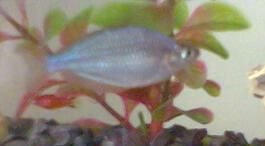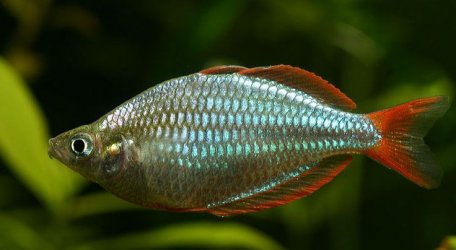platyperson
Fish Fanatic
Common name(s): Blue Neon Rainbowfish, Neon Rainbowfish, Blue Rainbow fish, Peacock Rainbowfish.
Scientific name: Melanotaenia praecox
Familly: Melanotaeniidae
Origin: New Guinea, near Iritoi, Siewa and Dabra and in the small areas of the Mamberamo river system.
Maximum size: 6cm (2 and a half Inches)
Care: When they are first introduced into the aquarium, they will hover a few centimetres above the ground, turn off the tank lights and they will settled in, in a matter of seconds. Temperature shouldnt exceed 81F, they require soft (60-100 mg/l) and acidic (Ph: 6.5-7.5)
water. They inhabit fast flowing waters so well oxygenated water and a medium to strong water current is essential to make them feel at home. They prefer floating plants to diffuse the light as this will intensify their colors and make them secure. They are extremely hardy, but do not let nitrates exceed 20 mg/l. Tanks between 15-20 gallons can easilly accomodate a shoal of three (two females and one male)
Feeding: They will take prepared, dry, vegi and livefoods although they prefer sinking foods, as they are very lazy! But if you have had them since they were fry they will get used to taking food directly from the surface. You MUST include some vegitable matter in their diet. A mixture of frozen livefoods (bloodworms and daphnia are recommended) and some vegitables (Lettuce and cucumber) are essential to ensure good coloration and immunity to disease. Peas that are not small enough will be ignored, cucumber seems to be a very good alternative.
Sexing and breeding: Males usually have red edgeing on the fins although you may occasionally get a female with this characteristic. Most females are light yellow/ gray finned. Both sexes are covered in beuatifull purple/blue scales. Condition the females in the same tank for three weeks. Give live brine shrimp, daphnia and tubifex worms. Have a spare tank ready, use a sandy substrate, and decorate with thin leaved plants or use a spawning mop.
Then transfer a couple of conditioned females to a spawning tank with a male. He will chase them into a section of plants while flaring his fins and intensing his colors. If the females are receptive to his display, they will lay there eggs. The fry can take over 2 weeks to hatch. Have an infusoria culture ready. The newborns will stay on the bottom of the tank. Around 14 hours after hatching, they will have absored their yolk sacs so give them there first feed using infusoria or a commercial subsititute.
Comments: These fishes are quite long lived, they make ideal begginers fish and will do better than most other livebearers as they do not require aquillibrium salt and they will not unexpectedly breed and cause iverpopulation as their breeding is very easilly controlled.
They are very beautifull and before you finish with your hobby, you must keep these fish they have amazing characters and colors. They are a real treat to watch. They socialise with other peacefull community fish, just avoid aggresive/ fin nipping tankmates. A recently discovered strain had a red line going through its body.
The picture provided is a male with the standard red male finnage.

Scientific name: Melanotaenia praecox
Familly: Melanotaeniidae
Origin: New Guinea, near Iritoi, Siewa and Dabra and in the small areas of the Mamberamo river system.
Maximum size: 6cm (2 and a half Inches)
Care: When they are first introduced into the aquarium, they will hover a few centimetres above the ground, turn off the tank lights and they will settled in, in a matter of seconds. Temperature shouldnt exceed 81F, they require soft (60-100 mg/l) and acidic (Ph: 6.5-7.5)
water. They inhabit fast flowing waters so well oxygenated water and a medium to strong water current is essential to make them feel at home. They prefer floating plants to diffuse the light as this will intensify their colors and make them secure. They are extremely hardy, but do not let nitrates exceed 20 mg/l. Tanks between 15-20 gallons can easilly accomodate a shoal of three (two females and one male)
Feeding: They will take prepared, dry, vegi and livefoods although they prefer sinking foods, as they are very lazy! But if you have had them since they were fry they will get used to taking food directly from the surface. You MUST include some vegitable matter in their diet. A mixture of frozen livefoods (bloodworms and daphnia are recommended) and some vegitables (Lettuce and cucumber) are essential to ensure good coloration and immunity to disease. Peas that are not small enough will be ignored, cucumber seems to be a very good alternative.
Sexing and breeding: Males usually have red edgeing on the fins although you may occasionally get a female with this characteristic. Most females are light yellow/ gray finned. Both sexes are covered in beuatifull purple/blue scales. Condition the females in the same tank for three weeks. Give live brine shrimp, daphnia and tubifex worms. Have a spare tank ready, use a sandy substrate, and decorate with thin leaved plants or use a spawning mop.
Then transfer a couple of conditioned females to a spawning tank with a male. He will chase them into a section of plants while flaring his fins and intensing his colors. If the females are receptive to his display, they will lay there eggs. The fry can take over 2 weeks to hatch. Have an infusoria culture ready. The newborns will stay on the bottom of the tank. Around 14 hours after hatching, they will have absored their yolk sacs so give them there first feed using infusoria or a commercial subsititute.
Comments: These fishes are quite long lived, they make ideal begginers fish and will do better than most other livebearers as they do not require aquillibrium salt and they will not unexpectedly breed and cause iverpopulation as their breeding is very easilly controlled.
They are very beautifull and before you finish with your hobby, you must keep these fish they have amazing characters and colors. They are a real treat to watch. They socialise with other peacefull community fish, just avoid aggresive/ fin nipping tankmates. A recently discovered strain had a red line going through its body.
The picture provided is a male with the standard red male finnage.




 /www.centralpets.com/animals/fish/fr...sh/fwf4605.html
/www.centralpets.com/animals/fish/fr...sh/fwf4605.html






